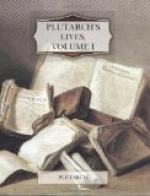IX. To Numa also is referred the institution of the Pontifices, or high priests; and he himself is said to have been one of the first. The Pontifices are so called, according to some authorities, because they worship the gods, who are powerful and almighty; for powerful in Latin is potens. Others say that it refers to an exception made in favour of possibilities, meaning that the legislator ordered the priests to perform what services lay in their power, and did not deny that there are some which they cannot. But the most usually received and most absurd derivation is that the word means nothing more than bridge builders, and that they were so named from the sacrifices which are offered upon the sacred bridge, which are of great sanctity and antiquity. The Latins call a bridge pontem. This bridge is intrusted to the care of the priests, like any other immovable holy relic; for the Romans think that the removal of the wooden bridge would call down the wrath of Heaven. It is said to be entirely composed of wood, in accordance with some oracle, without any iron whatever.
The stone bridge was built many years afterwards, when Aemilius was Quaestor. However, it is said that the wooden bridge itself does not date from the time of Numa, but that it was finished by Marcius, the grandson of Numa, when he was king.
The chief priest, or Pontifex Maximus, is an interpreter and prophet or rather expounder of the will of Heaven. He not only sees that the public sacrifices are properly conducted, but even watches those who offer private sacrifices, opposes all departure from established custom, and points out to each man how to honour the gods and how to pray to them. He also presides over the holy maidens called vestals.
The consecration of the vestal virgins, and the worship and watching of the eternal flame by them, are entirely attributed to Numa, and explained either by the pure and uncorruptible essence of fire being intrusted to the keeping of those who are stainless and undefiled, or by that which is barren and without fruit being associated with maidens.
Indeed, in Greece, wherever an eternal fire is kept up, as at Delphi and Athens, it is not maidens, but widows, past the age to wed, that tend it. When any of these fires chance to go out, as, for instance, the sacred lamp went out at Athens when Aristion was despot, and the fire went out at Delphi when the temple was burned by the Persians, and at Rome in the revolutions during the time of the wars with King Mithridates the fire, and even the altar upon which it burned, was swept away; then they say that it must not be lighted from another fire, but that an entirely new fire must be made, lighted by a pure and undefiled ray from the sun. They usually light it with mirrors made by hollowing the surface of an isosceles right-angled triangle, which conducts all the rays of light into one point. Now when it is placed opposite to the sun, so that all the rays coming from all quarters are collected together into that point, the ray thus formed passes through the thin air, and at once lights the dryest and lightest of the objects against which it strikes, for that ray has the strength and force of fire itself.




